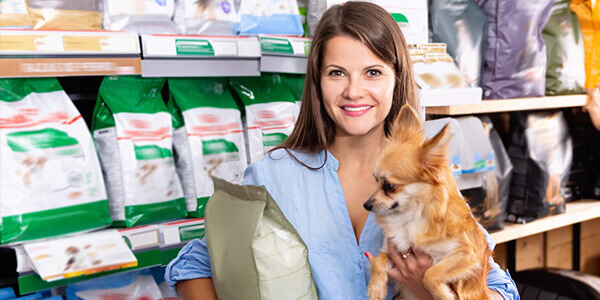Transition dog food

If you've found yourself needing to switch your dog's diet from puppy food to adult dog food then you may be wondering how to transition dog food safely with minimal digestive upset.
To transition your dog's food, gradually mix the new food in with their current food over a period of 5-7 days. This helps their digestive system adjust to the new ingredients and minimizes the risk of an upset stomach.
Why Transition Gradually?
Your dog's digestive system is balanced with their food's specific ingredients. If you introduce a new diet abruptly (even a better one), it can disrupt this delicate harmony, leading to unpleasant symptoms like vomiting, diarrhea, and gas. Switching dog food gradually gives your dog's tummy time to adjust and prevents these uncomfortable symptoms from popping up. Some dogs need a slower transition than others, but we will show you the signs to watch out for if you're transitioning your dog's food too quickly. Switching dog foods properly is especially important for dogs with a job to do, such as emotional support animals and service dogs. Not transitioning properly can put them out of the game for a few days.
How to transition
As a general rule of thumb, most dogs can be transitioned to a different diet using this
schedule:
Day 1-2:
Start by introducing just a sprinkle of the new dog food mixed with your dog's current
food, around 10%. If your dog is very small, this may literally be a few pieces of kibble. You
want to start as small as possible while still giving your dog enough to chew on.
Day 3-4:
If everything goes smoothly, you can increase their portion size. Gradually bump up the
new food to around 35-50% of the mix, decreasing their usual kibble proportionally. In the
meantime, keep watching them for symptoms of digestive upset.
Day 5-7:
Assuming your dog is adjusting well, it's time to give them more of the new food than
the old. Bump up the portion of new food to 75% of the mix, leaving just 25% of the old kibble.
Day 8 and beyond:
Once you've reached this final stage, your dog should be well-adjusted! It
should be safe enough for you to start feeding only the new kibble.
If your dog's stomach is particularly sensitive, it may take longer than eight days to change
your dog's food. During the transition phase, if your dog experiences any digestive upset, you
might be changing dog foods too fast. Decrease the amount of new food
and wait another couple of days before increasing it again.
Smooth transition
Even the most well-thought-out plan, like the one mentioned above, will likely require some
adjustments. Here are some tips and tricks to assist you in troubleshooting the transition
process:
Schedule is key!
Consistency is your best friend when transitioning your dog's food.
Stick to a regular feeding schedule so that you can better monitor your dog for symptoms and
adjust their kibble mix accordingly.
Stay patient:
While most dogs can transition to a new food within a week, many dogs
may need a few extra days or even have the process spread out over a month! This isn't
necessarily a sign that your dog's digestive health is poor. It just means
that their stomach is a bit more sensitive.
Longer durations:
The more different the new food is, the more likely your dog is to
have problems transitioning. If you're switching to a very different formula, like a fresh dog
food, consider spreading the process out over a longer period of
time.
For those of us who are away regularly, or have nine-to-five jobs, we may have to enlist a dog walking service to help our pets get enough exercise and human contact during the daytime. Using dogwalking services London to help get your dog used to socialising and being around other dogs. This, in turn, will help them be far more willing to behave when taking them out yourself in social situations. Searching for dogwalkers London will help you find local dog-sitters in your area. These places also offer doggy day care, which could be ideal for dogs that get shy or nervous in the presence of other dogs.
Adopting a shy and nervous dog might seem like an uphill challenge to begin with. Giving them small tasks and increasing the challenge over time will eventually show your pup that there's nothing to really worry about. Remember to always be patient, however, as throwing them in the deep end can be more stress than it's really worth.
